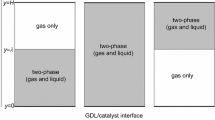Abstract
An isothermal model of the cathode part of a polymer electrolyte membrane fuel cell is considered with allowance for capillary forces. Numerical and analytical solutions show that the capillary forces have a fundamental effect on the voltage-current characteristic because of an abrupt increase in the diffusion loss of oxygen through a thin liquid film emerging in nonwettable pores of the cathode in comparison with the ordinary diffusion in gas channels. The results obtained agree well with known experimental data.
Similar content being viewed by others
Abbreviations
- a, b :
-
dimensionless parameters
- C:
-
dimensionless concentration
- c:
-
concentration
- D:
-
diffusion coefficient
- e, f :
-
dimensionless parameters
- F:
-
Faraday’s constant
- ΔG :
-
Gibbs free energy
- i ref0 :
-
bulk density of exchange current
- J:
-
dimensionless current density
- j:
-
ion current density profiles
- j ch :
-
exchange current density in the catalytic layer
- j in :
-
internal current density
- K:
-
dimensionless parameter
- \(K_{O_2 } \) :
-
Henry’s constant
- k E :
-
electrokinetic permeability
- k h :
-
hydraulic permeability
- l:
-
layer thickness
- N:
-
molar flow rate of a substance
- p:
-
pressure
- R:
-
gas constant
- r:
-
specific resistance
- s:
-
water saturation
- T:
-
absolute temperature
- U:
-
voltage
- u:
-
water velocity
- v:
-
dimensionless oxygen flow rate
- x:
-
dimensionless molar concentration
- y:
-
dimensionless parameter
- z:
-
coordinate
- α:
-
mass-transfer coefficient
- β:
-
approximation parameter in the Leverett function
- ε:
-
porosity
- κ:
-
electrical conductivity of the membrane
- λ1, λ2 :
-
eigenvalues
- μ:
-
water viscosity
- ξ:
-
dimensionless coordinate
- ρ:
-
water density
- σ:
-
water surface tension
- ϕ:
-
electric potential
- a:
-
anode
- c:
-
catalytic layer
- d:
-
gas diffusion region
- eff:
-
effective value
- g:
-
gas phase
- H:
-
proton
- in:
-
internal value
- m:
-
membrane
- max:
-
maximal value
- O2 :
-
oxygen
- O2-N2 :
-
oxygen-nitrogen mixture
- out:
-
outlet value
- q:
-
liquid water
- ref:
-
reference value
- sat:
-
saturated state
- th:
-
theoretical value
- w:
-
water diffusion region
- w-N2 :
-
water vapor-nitrogen mixture
- w-O2 :
-
water vapor-oxygen mixture
- O:
-
on the membrane side
References
Larminie, J. and Dicks, A., Fuel Cell System Explained, Chichester, West Sussex: Wiley, 2003.
Newman, J.S., Electrochemical Systems, Englewood Cliffs, NJ: Prentice-Hall, 1973.
Costamagna, P. and Srinivasan, S., Quantum Jumps in the PEMFC Science and Technology from the 1960s to the Year 2000, J. Power Sources, 2001, vol. 102, nos. 1–2, pp. 242–269.
Nam, J.H. and Kaviany, M., Effective Diffusivity and Water-Saturation Distribution in Single-and Two-Layer PEMFC Diffusion Medium, Int. J. Heat Mass Transfer, 2003, vol. 46, no. 24, pp. 4595–4611.
Bernardi, D.M. and Verbrugge, M.W., Mathematical Model of Gas Diffusion Electrode Bonded to a Polymer Electrolyte, AIChE J., 1991, vol. 37, no. 8, pp. 1151–1163.
Collins, R.E., Flow of Fluids through Porous Materials, New York: Reinhold, 1961. Translated under the title Techeniya zhidkostei cherez poristye materialy, Moscow: Mir, 1964.
Najjari, M. and Nasrallah, S., B. Numerical Study of the Effects of Geometric Dimension on Liquid-Vapor Phase Change and Free Convection in a Rectangular Porous Cavity, J. Porous Media, 2005, vol. 8, no. 1, pp. 1–12.
Ticianelli, E.A., Derouin, C.R., and Srinivasan, S., Localization of Platinum in Low Catalyst Loading Electrodes to Attain High Power Densities in SPE Fuel Cells, J. Electroanal. Chem., 1988, vol. 251, no. 2, pp. 275–295.
Author information
Authors and Affiliations
Additional information
Original Russian Text © V.E. Nakoryakov, V.G. Gasenko, 2006, published in Teoreticheskie Osnovy Khimicheskoi Tekhnologii, 2006, Vol. 40, No. 2, pp. 130–140.
Rights and permissions
About this article
Cite this article
Nakoryakov, V.E., Gasenko, V.G. Effect of the capillary forces in porous electrodes on the voltage-current characteristic of polymer electrolyte membrane fuel cells. Theor Found Chem Eng 40, 116–125 (2006). https://doi.org/10.1134/S0040579506020035
Received:
Issue Date:
DOI: https://doi.org/10.1134/S0040579506020035



